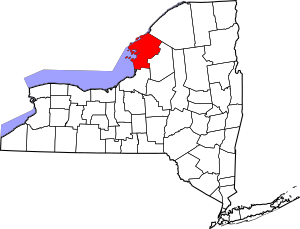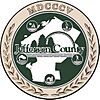Jefferson County, New York facts for kids
Quick facts for kids
Jefferson County
|
|||
|---|---|---|---|

Panoramic view of Boldt Castle on Heart Island
|
|||
|
|||

Location within the U.S. state of New York
|
|||
 New York's location within the U.S. |
|||
| Country | |||
| State | |||
| Founded | 1805 | ||
| Named for | Thomas Jefferson | ||
| Seat | Watertown | ||
| Largest town | Le Ray | ||
| Area | |||
| • Total | 1,857 sq mi (4,810 km2) | ||
| • Land | 1,269 sq mi (3,290 km2) | ||
| • Water | 589 sq mi (1,530 km2) 32% | ||
| Population
(2020)
|
|||
| • Total | 116,721 |
||
| • Density | 63/sq mi (24/km2) | ||
| Time zone | UTC−5 (Eastern) | ||
| • Summer (DST) | UTC−4 (EDT) | ||
| Congressional districts | 21st, 24th | ||
Jefferson County is a county located in the northern part of New York. It sits right on the border with Canada. In 2020, about 116,721 people lived here.
The main city and county seat is Watertown. The county is named after Thomas Jefferson, who was the third President of the United States of America. Jefferson County is next to Lake Ontario and is part of New York's "North Country" region.
This area is popular for summer tourists. The population grows a lot during the warmer months. Fort Drum, a large United States Army base, is also located here. It is home to the 10th Mountain Division.
In 2014, Colleen M. O'Neill became the first woman county sheriff in New York State. She had worked with the New York State Police for 32 years before that.
Contents
History of Jefferson County
When counties were first created in New York in 1683, the land that is now Jefferson County was part of a huge area called Albany County. This county was enormous, stretching across much of New York and even into what is now Vermont.
Over many years, Albany County was divided into smaller parts. In 1772, a large western section became Tryon County. This county was named after William Tryon, who was the colonial governor.
After the American Revolutionary War, the name of Tryon County was changed to Montgomery County. This honored General Richard Montgomery, a hero of the war.
Later, in 1791, Herkimer County was formed from Montgomery County. Then, in 1798, Oneida County was created from Herkimer County.
Finally, in 1805, Jefferson County was officially created. It was split off from Oneida County. In 1817, Carleton Island, which was captured during the War of 1812, became part of Jefferson County.
Geography and Nature
Jefferson County covers a total area of about 1,857 square miles (4,810 km²). About 1,269 square miles (3,287 km²) of this is land, and 589 square miles (1,525 km²) is water. This makes it the fourth-largest county in New York by total area.
The county is in northeastern New York State. It is located where the Saint Lawrence River flows out of Lake Ontario. It's northeast of Syracuse and northwest of Utica. The county also shares an international border with Canada.
The Black River is an important waterway here. It flows into Lake Ontario. Part of the Tug Hill Plateau is in the southern part of the county. Jefferson County also includes some of the beautiful Thousand Islands in the St. Lawrence River. These include large islands like Carleton Island, Grindstone Island, and Wellesley Island.
Neighboring Counties
Jefferson County shares borders with these other counties:
- St. Lawrence County – to the northeast
- Lewis County – to the southeast
- Oswego County – to the southwest
- Leeds and Grenville United Counties, Ontario – to the north (in Canada)
- Frontenac County, Ontario – to the northwest (in Canada)
Main Roads
Many important roads run through Jefferson County. These include:
 Interstate 81
Interstate 81 U.S. Route 11
U.S. Route 11 New York State Route 3
New York State Route 3 New York State Route 3A
New York State Route 3A New York State Route 12
New York State Route 12 New York State Route 12E
New York State Route 12E New York State Route 26
New York State Route 26 New York State Route 37
New York State Route 37 New York State Route 180
New York State Route 180
Population Data
| Historical population | |||
|---|---|---|---|
| Census | Pop. | %± | |
| 1810 | 15,140 | — | |
| 1820 | 32,952 | 117.6% | |
| 1830 | 48,493 | 47.2% | |
| 1840 | 60,984 | 25.8% | |
| 1850 | 68,153 | 11.8% | |
| 1860 | 69,825 | 2.5% | |
| 1870 | 65,415 | −6.3% | |
| 1880 | 66,103 | 1.1% | |
| 1890 | 68,806 | 4.1% | |
| 1900 | 76,748 | 11.5% | |
| 1910 | 80,382 | 4.7% | |
| 1920 | 82,250 | 2.3% | |
| 1930 | 83,574 | 1.6% | |
| 1940 | 84,003 | 0.5% | |
| 1950 | 85,521 | 1.8% | |
| 1960 | 87,835 | 2.7% | |
| 1970 | 88,508 | 0.8% | |
| 1980 | 88,151 | −0.4% | |
| 1990 | 110,943 | 25.9% | |
| 2000 | 111,738 | 0.7% | |
| 2010 | 116,229 | 4.0% | |
| 2020 | 116,721 | 0.4% | |
| U.S. Decennial Census 1790–1960 1900–1990 1990–2000 2020 |
|||
2020 Census Information
The 2020 Census showed the different groups of people living in Jefferson County:
| Race | Number of People | Percentage |
|---|---|---|
| White (not Hispanic) | 92,755 | 79.5% |
| Black or African American (not Hispanic) | 6,271 | 5.4% |
| Native American (not Hispanic) | 461 | 0.4% |
| Asian (not Hispanic) | 2,185 | 1.9% |
| Pacific Islander (not Hispanic) | 300 | 0.3% |
| Other/Mixed (not Hispanic) | 6,759 | 5.8% |
| Hispanic or Latino | 7,990 | 6.85% |
Education in the County
Jefferson Community College in Watertown offers higher education.
Many school districts serve the students in Jefferson County:
- Alexandria Central School District
- Belleville Henderson Central School District
- Carthage Central School District
- Copenhagen Central School District
- General Brown Central School District
- Gouverneur Central School District
- Hammond Central School District
- Indian River Central School District
- La Fargeville Central School District
- Lyme Central School District
- Sackets Harbor Central School District
- Sandy Creek Central School District
- South Jefferson Central School District
- Thousand Islands Central School District
- Watertown City School District
Some parts of Fort Drum send their students to the Carthage or Indian River school districts.
Cities, Towns, and Villages
Jefferson County has one city, many towns, and several villages.
City
- Watertown (This is the county seat.)
Towns
Villages
Hamlets
These smaller communities are called hamlets. Many are also recognized as census-designated places.
- Adams Center
- Belleville
- Calcium
- Depauville
- Felts Mills
- Fishers Landing
- Fort Drum
- Great Bend
- Henderson
- La Fargeville
- Lorraine
- Natural Bridge
- Oxbow
- Pamelia Center
- Pierrepont Manor
- Plessis
- Redwood
- Rodman
- Sanfords Four Corners
- Thousand Island Park
- Three Mile Bay
Places to Visit
Jefferson County has many interesting places to see and explore:
- Antique Boat Museum
- Boldt Castle
- Burnham Point State Park
- Canoe-Picnic Point State Park
- Cape Vincent
- Carleton Island
- Cedar Point State Park
- Clayton
- Dewolf Point State Park
- Duffy Fairgrounds
- Fairview Manor
- Fort Drum
- Grass Point State Park
- Grenadier Island
- Grindstone Island Upper Schoolhouse
- Lake Ontario National Marine Sanctuary
- National Register of Historic Places listings in Jefferson County, New York
- Orleans
- Paddock Arcade
- Paddock Mansion
- Public Square Historic District
- Roswell P. Flower Memorial Library
- Sackets Harbor
- Sackets Harbor Battlefield State Historic Site
- Thousand Islands
- Thousand Islands National Park
- Tibbetts Point Lighthouse
- Union Hotel (Sackets Harbor, New York)
- Watertown
- Wellesley Island State Park
- Thousand Islands Arts Center
See also
 In Spanish: Condado de Jefferson (Nueva York) para niños
In Spanish: Condado de Jefferson (Nueva York) para niños



